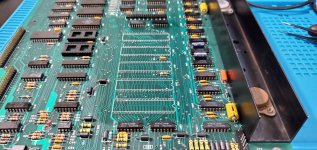A good paint that is close is just a shade of off white, not vivid white. It is a type of spray lacquer made by Dupli-Color, the particular one fairly close to a PET but just a shade lighter is DST-56.
Find many great new & used options and get the best deals for Dupli-Color Spray Paint Tudor White / Glacial White 150g - DST56 at the best online prices at eBay!
www.ebay.com.au
This paint has the advantage of a highly volatile solvent, quick drying, it surface etches well into most aged paint and plastics and gives an amazing bond that won't flake off. Also, unless you go out of your way to over apply it, it is very thin and it allows preservation of the original textured paint or plastic. But, I'm not sure of its equivalent product in Oregon. You can use standard auto shop body filler for the plastic repairs & this paint is compatible with those.
Surface rust is best treated with Fertan organic rust converter, that changes the rust crystals into a harmless non progressive dark blue-black compound.
If I had a badly rusted black metal pan, I probably would get it fine garnet bead blasted and re-electroplated with Zinc, to make sure the rust was eliminated and send it to the Power Coaters, because powder coating gives a great finish, is super adherent and scratch resistant and amazingly long lasting in an indoor setting. Have a look at the black transformer covers and and EHT cage (done with this method) for a vintage 1946 TV restoration. The EHT cage case was even more elaborate, I got the powder coaters to mix up some special coat that looked very similar to the original dark copper like finish on the cage. As usual I might have gone too far.
www.worldphaco.com/621TSARTICLE.pdf
But if you don't want to go that far I would use the Fertan on it and use Dupli-color gloss black.
Find many great new & used options and get the best deals for Dupli-Color Spray Paint Gloss Black 150g - DS105 at the best online prices at eBay!
www.ebay.com.au
There are some remarks in this article about restoring rusty PET VDU housings:
The paint on that second restored VDU is a whiter shade of white compared to the DST56.
One point, I would completely avoid both enamel and acrylic paints and other products with those bases claiming rust inhibition. They are too soft, don't adhere well without the correct undercoats, have a habit of peeling off and to get right usually require oven baking. The also don't bond well with old paint, as they (their solvent) doesn't etch the surface well.
I'm not saying that there is anything wrong with an enamel painted surface that has been properly done in a commercial setting and baked on, But in a home workshop environment, for equipment restorations, the results relating to surface bonding, wear and flaking resistance with enamels & acrylics are much poorer than the automotive lacquers like Dupli Color. Not everybody is aware of this, and those who have tried plastic case restorations with acrylics and enamels usually meet with disaster, and cannot consider the notion of painting plastic as a restoration technique. But, not all know about paints like Dupli-Color with the quick drying highly volatile solvents or have experience with them. I have a lot of experience with Dupli-Color, I have used it extensively in electronic & automotive restoration work since the 1970's. And I'm pretty fussy with my restorations as you can see from that TV article.




![20221118_165401[1].jpg 20221118_165401[1].jpg](https://forum.vcfed.org/data/attachments/70/70398-63c24a9e4832c08593012eb662477154.jpg)
![20221118_205653[1].jpg 20221118_205653[1].jpg](https://forum.vcfed.org/data/attachments/70/70401-2aba1cc7ee05f98c0e520bf2e44a9f6d.jpg)
![20221118_211138[1].jpg 20221118_211138[1].jpg](https://forum.vcfed.org/data/attachments/70/70399-5b92b782a48ca85419847dd7f9e2d886.jpg)
![20221118_205516[1].jpg 20221118_205516[1].jpg](https://forum.vcfed.org/data/attachments/70/70400-73c30e5ffac5a3a1853f87f1bbae581a.jpg)
![20221117_184316[1].jpg 20221117_184316[1].jpg](https://forum.vcfed.org/data/attachments/70/70402-99762db78ff6cf352bc9ee0d83d0ec6d.jpg)





